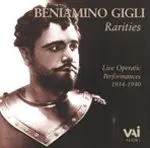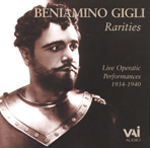Beniamino Gigli Rarities - Live Operatic Performances 1934-1940
Classical | 1 CD | FLAC CUE LOG | NO BOOKS NO COVER | 202 MB
VAI AUDIO VAIA 1199 | Release Date: 2001
Beniamino Gigli was the foremost Italian tenor of the 1920s through the 1940s, possessed of a smooth, lush voice with a lyric sweetness often described as "honeyed." He became a Metropolitan Opera star, singing 28 roles there, and was a legitimate heir to the tenor Enrico Caruso, who had died at the beginning of the 1920s. No one person could fill Caruso's shoes, but it was widely conceded that Gigli inherited his lyrical and romantic parts, while Giovanni Martinelli took over the more heroic roles. Gigli was also one of the most-beloved performers of Italian song, with a special gift for the traditional Neapolitan repertoire. His singing was heavily mannered by modern standards, characterized by sobs, catches, and portamenti, but it had an inherent beauty and sincerity that are still easy to appreciate. Although an even more stylized actor than singer, Gigli had a successful film career, appearing in almost 20 films.Gigli began his singing career as a child, performing for treats and coins at a local café. At age 7, he entered the choir of Recanati Cathedral, where his father was Sacristan. When he was 15 and still a boy soprano, he was recruited to sing the heroine in an operetta in the nearby city of Macerata; he did the production in drag! When he was 17, he moved to Rome to live with his brother, a student of sculpture; the two led a bohemian existence, frequently cold and hungry, until Gigli was offered a position as a servant in a wealthy household. There he was provided with room and board and given afternoons off to practice or to take lessons with a local teacher, Agnese Bonucci, who offered to teach him at no cost.
During World War I, a music-loving colonel saw to it that he was posted to a non-combat position in Rome and also encouraged him to audition at the famous Academia di Santa Cecilia, where his evident musical talent led them to waive the normally required piano examination. He studied there for two years, and upon graduation won the famous Parma vocal competition. On the strength of that, he was offered roles at various small opera houses and made his official opera debut as Enzo in La Gioconda at Rovigo in the fall of 1914. By December 1916, he made his Rome Opera debut as Faust in Boito's Mefistofele. When the war was over, the recording company HMV set up a studio in Milan, and it was there that Gigli began his extensive recording career. In 1918, he made his La Scala debut also as Boito's Faust in a performance conducted by Toscanini. The next year, he made his first appearance in the Americas as Cavaradossi in Tosca at the Teatro Colon. His Met debut followed in November 1920, also as Faust, and he sang there every season until 1932.
His Covent Garden debut was not until 1930, as Andrea Chénier. After World War II, which he mostly spent in Italy, he largely restricted his singing to concert performances; his last public appearance was in May 1955, at a concert in Washington, D.C., ending a professional career of 41 years.
Gigli was one of the first singers to make complete opera recordings, including a particularly fine Andrea Chénier (EMI) and Cavalleria rusticana and Pagliacci released as a set on Nimbus. Among his solo CDs, a two-disc set on Pearl (Gemm) captures him in his youthful prime.
Tracklist
Charles Gounod: ROMEO ET JULIETTE (Sung in Italian)
1. L’amour! L’amour . . . Ah! lève-toi, soleil! (4:45)
2. Hélas! moi, le haïr (6:57)
3. Ô nuit divine! . . . Ah! ne fuis pas encore! . . . Va! repose en paix! (9:38) *
with Mafalda Favero (Juliette); Aristide Baracchi (Grégorio)
Teatro alla Scala, Milan / Gabriele Santini, conductor; April 5, 1934
Giuseppe Verdi: LA FORZA DEL DESTINO
4. Che! Inorridi di Calatrava al nome . . . Solenne in quest’ora (4:55)
5. Invano Alvaro (ends after the words "Lasciatemi, lasciatemi") . . . (3:06) *
6. Non si placa il mio furor (to end of duet) (3:14)
with Carlo Morelli (Don Alvaro)
Teatro alla Scala, Milan / Gabriele Santini, conductor; March 31, 1934
Jules Massenet: MANON (Sung in Italian)
7. Instant charmant . . . En ferment les yeux (4:24)
with Pia Tassinari (Manon)
Teatro Reale dell’Opera, Rome / Vincenzo Bellezza, conductor; April 8, 1938
Giacomo Puccini: TOSCA
8. E lucevan le stelle . . . Ah! franchigia a Floria Tosca
(ends after the words "alla sua brama mi promisi") (4:01) *
with Iva Pacetti (Tosca)
Royal Opera, Covent Garden, London / Vittorio Gui, conductor; June 2, 1938
Umberto Giordano: ANDREA CHENIER
9. Commosso, lusingato . . . (6:34)
10. Signor Chénier — Madama la Contessa . . . (2:53)
11. Colpito qui m’avete . . . Un dì all’azzurro spazio (5:54)
with Elisabeth Rethberg (Maddalena); Doris Doe (La Contessa di Coigny);
John Howell (Fleville); Lodovico Oliviero (L’Abate)
San Francisco Opera / Gaetano Merola, conductor; October 7, 1938
Giuseppe Verdi: LA FORZA DEL DESTINO
12. Le minaccie, i fieri accenti (ends after the words "Un brando! Uscite!") (4:30)
with Benvenuto Franci (Don Alvaro)
Teatro Reale dell’Opera, Rome, at the Terme di Caracalla
Tullio Serafin, conductor; July 4, 1939
Giuseppe Verdi: IL TROVATORE
13. Di quella pira (December 9, 1939) (2:07)
14. Di quella pira (December 24, 1939) (2:07)
Teatro Reale dell’Opera, Rome / Olivero de Fabritiis
Francesco Cilea: ADRIANA LECOUVREUR
15. La dolcissima effigie (4:10)
with Magda Olivero (Adriana)
Teatro Reale dell’Opera, Rome / Mario Rossi, conductor; March 20, 1940
* Note: due to imperfections in the original sources, some music is missing
at the very start of tracks 3, 5, and 8.
act Audio Copy V0.99 prebeta 5 from 4. May 2009
EAC extraction logfile from 15. September 2009, 17:57
Beniamino Gigli / Beniamino Gigli Rarities-Live Operatic Performances 1934-1940
Used drive : PLDS DVD+-RW DL-8ATS Adapter: 1 ID: 0
Read mode : Secure
Utilize accurate stream : Yes
Defeat audio cache : No
Make use of C2 pointers : No
Combined read/write offset correction : 0
Overread into Lead-In and Lead-Out : No
Fill up missing offset samples with silence : Yes
Delete leading and trailing silent blocks : No
Null samples used in CRC calculations : No
Used interface : Native Win32 interface for Win NT & 2000
Used output format : User Defined Encoder
Selected bitrate : 768 kBit/s
Quality : High
Add ID3 tag : No
Command line compressor : C:\Program Files\Exact Audio Copy\FLAC\FLAC.EXE
Additional command line options : -6 -V -T "ARTIST=%a" -T "TITLE=%t" -T "ALBUM=%g" -T "DATE=%y" -T "TRACKNUMBER=%n" -T "GENRE=%m" -T "COMMENT=%e" %s -o %d
TOC of the extracted CD
Track | Start | Length | Start sector | End sector
––––––––––––––––––––––––––––-
1 | 0:00.01 | 4:41.46 | 1 | 21121
2 | 4:41.47 | 6:54.48 | 21122 | 52219
3 | 11:36.20 | 9:40.14 | 52220 | 95733
4 | 21:16.34 | 4:53.59 | 95734 | 117767
5 | 26:10.18 | 3:01.59 | 117768 | 131401
6 | 29:12.02 | 3:16.64 | 131402 | 146165
7 | 32:28.66 | 4:22.46 | 146166 | 165861
8 | 36:51.37 | 4:00.16 | 165862 | 183877
9 | 40:51.53 | 6:29.46 | 183878 | 213098
10 | 47:21.24 | 2:52.67 | 213099 | 226065
11 | 50:14.16 | 5:56.11 | 226066 | 252776
12 | 56:10.27 | 4:24.66 | 252777 | 272642
13 | 60:35.18 | 2:05.43 | 272643 | 282060
14 | 62:40.61 | 2:03.34 | 282061 | 291319
15 | 64:44.20 | 4:10.52 | 291320 | 310121
Range status and errors
Selected range
Filename E:\Temp\BGRLOP.wav
Peak level 73.2 %
Range quality 100.0 %
Copy CRC C4CCCD64
Copy OK
No errors occurred
End of status report
EAC extraction logfile from 15. September 2009, 17:57
Beniamino Gigli / Beniamino Gigli Rarities-Live Operatic Performances 1934-1940
Used drive : PLDS DVD+-RW DL-8ATS Adapter: 1 ID: 0
Read mode : Secure
Utilize accurate stream : Yes
Defeat audio cache : No
Make use of C2 pointers : No
Combined read/write offset correction : 0
Overread into Lead-In and Lead-Out : No
Fill up missing offset samples with silence : Yes
Delete leading and trailing silent blocks : No
Null samples used in CRC calculations : No
Used interface : Native Win32 interface for Win NT & 2000
Used output format : User Defined Encoder
Selected bitrate : 768 kBit/s
Quality : High
Add ID3 tag : No
Command line compressor : C:\Program Files\Exact Audio Copy\FLAC\FLAC.EXE
Additional command line options : -6 -V -T "ARTIST=%a" -T "TITLE=%t" -T "ALBUM=%g" -T "DATE=%y" -T "TRACKNUMBER=%n" -T "GENRE=%m" -T "COMMENT=%e" %s -o %d
TOC of the extracted CD
Track | Start | Length | Start sector | End sector
––––––––––––––––––––––––––––-
1 | 0:00.01 | 4:41.46 | 1 | 21121
2 | 4:41.47 | 6:54.48 | 21122 | 52219
3 | 11:36.20 | 9:40.14 | 52220 | 95733
4 | 21:16.34 | 4:53.59 | 95734 | 117767
5 | 26:10.18 | 3:01.59 | 117768 | 131401
6 | 29:12.02 | 3:16.64 | 131402 | 146165
7 | 32:28.66 | 4:22.46 | 146166 | 165861
8 | 36:51.37 | 4:00.16 | 165862 | 183877
9 | 40:51.53 | 6:29.46 | 183878 | 213098
10 | 47:21.24 | 2:52.67 | 213099 | 226065
11 | 50:14.16 | 5:56.11 | 226066 | 252776
12 | 56:10.27 | 4:24.66 | 252777 | 272642
13 | 60:35.18 | 2:05.43 | 272643 | 282060
14 | 62:40.61 | 2:03.34 | 282061 | 291319
15 | 64:44.20 | 4:10.52 | 291320 | 310121
Range status and errors
Selected range
Filename E:\Temp\BGRLOP.wav
Peak level 73.2 %
Range quality 100.0 %
Copy CRC C4CCCD64
Copy OK
No errors occurred
End of status report
daxhund
NO MIRRORS!!!



